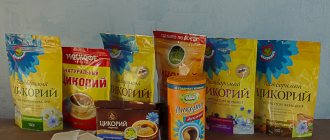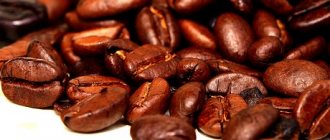The glycemic index (abbreviated as GI) is a value that reflects the effect of carbohydrates in food on blood glucose levels. For diseases of the pancreas, including pancreatitis, diabetes mellitus and others, the glycemic index of foods should be low, since in this case there is no increase in the activity of the organ. This can affect the well-being of people with pancreatic dysfunction: pain, digestive problems, and increased blood sugar. In addition, foods with a low glycemic index are useful for preventing the onset of chronic diseases and maintaining normal or reducing excess weight.
General information
The Middle East is considered the birthplace of coffee. The plant was brought to Europe in the first half of the 16th century. Its aromatic fruits contain more than 1000 organic and inorganic substances.
The composition varies depending on the variety, region of growth, and degree of roasting.
Thanks to caffeine, the drink gives a burst of energy, although there is little of it in the beans (up to 1.5%). Coffee beans are rich in carbohydrates, proteins, organic acids, B vitamins, and phenols.
Composition, calorie content and GI
Black coffee without additives contains few calories: 100 ml of natural ground coffee contains 1-2 kcal.
The granules contain up to 12 kcal due to the presence of stabilizers, flavors and other substances. If you add other ingredients to it, the calorie content will increase. For example, 1 teaspoon of sugar contains about 24 kcal, milk - from 6 to 10 kcal, and cream - up to 45 kcal (depending on the percentage of fat content).
More than 60% of the structure of coffee beans is carbohydrates. Among them, fiber and sucrose predominate, which is 3–7% in Robusta and 9% in Arabica. The grains contain 13–14% protein.
During heat treatment, they bind to carbohydrates. As a result of the reaction, kafeol is released (consists of 250 compounds), thanks to which the drink receives a characteristic aroma. Arabica contains up to 18% fat, Robusta – about 13%.
Coffee contains the following vitamins and minerals:
- pyridoxine (B6);
- thiamine (B1);
- riboflavin (B2);
- tocopherol (E);
- nicotinic acid (PP);
- vitamins D and A;
- magnesium;
- potassium and calcium;
- iron;
- manganese;
- zinc.
The natural product includes many organic acids, tannins, and phenols. Only 15–20% of the beneficial composition remains in instant coffee, the rest are flavors, flavor enhancers, dyes, and preservatives.
Coffee eliminates fatigue due to caffeine, the concentration of which is 1–1.5% (more in Robusta than in Arabica). During heat treatment, its amount increases, which leads to an increase in blood glucose levels.
The glycemic index of natural coffee is 42–53, instant coffee – up to 60 units. The indicator depends on the variety, place of cultivation, and method of preparation. The lowest GI is in ristretto and espresso, the highest in Turkish-made drinks.
Vegetables
Vegetables are a source of vitamins, microelements, and fiber. The combination of this type of product in the diet has a beneficial effect on the human body, normalizes the functioning of the gastrointestinal tract, and increases the likelihood of absorption of each vitamin included in the composition. Vegetables should be an obligatory part of the daily menu of not only a sick person, but also a healthy person.
The products contain virtually no lipids and have low levels of proteins and carbohydrates. In most cases - low-calorie. The main value of vegetables is that they have a significant amount of ascorbic acid, pectin, folic acid, carotene, and minerals. The daily requirement is at least 600 g.
The table shows the GI indicators and calorie content of the most popular vegetables.
GI and calorie data - the ability to add or exclude necessary products
How to increase your vegetable intake
Harm and contraindications
Any coffee should be consumed in moderation, as caffeine is addictive.
A person's sleep is disturbed, hand tremors, headaches, increased anxiety, depression, and hypertension occur. In rare cases, allergies occur. Drinking this drink is contraindicated for the following diseases:
- gastritis;
- colitis;
- stomach and duodenal ulcers;
- pyelonephritis;
- kidney failure;
- urolithiasis;
- problems with the cardiovascular system.
If you drink a lot of coffee every day, calcium and beneficial minerals are quickly washed out of your body.
Therefore, it is better to avoid it for people over 60 years of age and children under 18 years of age. The drink should not be drunk during pregnancy due to the risk of premature birth. It can cause disturbances in the formation of the nervous system, skeleton and internal organs of the fetus. Caffeine accumulates in breast milk, increasing the baby's excitability. Therefore, coffee is not drunk during lactation.
Beverages
Mineral water is one of the recommended drinks, which is used for daily consumption (table water) and as a component of therapeutic measures (medical table water, medicinal mineral water).
It should be remembered that carbonated mineral water should be avoided.
Juices are another storehouse of vitamins and microelements. Preference is given to freshly made drinks rather than store-bought ones, which contain a significant amount of dyes and preservatives. Experts found the juices of lemon, tomatoes, blueberries, potatoes and pomegranate to be the most useful. In order to add a slight sweetness, add a little honey or maple syrup.
Although coffee is considered a metabolic stimulant, it is better to discuss its use with your doctor or nutritionist. When it comes to tea, preference is given to green varieties, as well as self-made herbal teas based on raspberry and blueberry leaves.
It is better to exclude alcoholic drinks from the diet altogether. Sometimes it is allowed to drink dry red wine (no more than a glass), forty-degree drinks (no more than 70-100 ml). It is better to avoid liqueurs, champagne, and sweet alcoholic cocktails, especially for patients with diabetes.
Drinks are an important component of the daily diet, which also requires correction.
Experts' opinion
Maxim Stepanov, endocrinologist, 25 years of experience Coffee has an ambiguous effect on blood sugar levels.
On the one hand, it helps increase cell tolerance to insulin and temporarily normalizes its levels, on the other hand, it can increase the amount of glucose by 8-10%. Therefore, people with diabetes are allowed to drink natural coffee, but the daily intake is limited. Ekaterina Malyarova, nutritionist, 11 years of experience People with this diagnosis should not completely give up coffee. It includes many useful substances that help control weight, speed up metabolism, and support the functioning of the cardiovascular system. The main rules are to drink only natural coffee, limit yourself to 3 cups per day, and do not add sugar or cream.
Dairy
These are the best sources of calcium, the intake of which is important for the prevention of diseases of the musculoskeletal system. In addition, calcium promotes normal collagen synthesis, ensures dental health, and supports muscle function. Milk has bactericidal properties, can reduce radioactive effects on the body, and binds toxic substances.
Experts have proven the positive effects of fermented milk products on the body. They are absorbed several times faster than milk, improve the functioning of the gastrointestinal tract, restoring normal microflora, and normalize the functioning of the liver and kidneys.
Each of the products has a specific effect, making it good to use:
- kefir – prevents intestinal infections, normalizes the functioning of the central and peripheral nervous system;
- sour cream – evens out hormonal balance;
- cheese – strengthens bones;
- cottage cheese – is responsible for the functioning of the cartilage system, participates in recovery processes;
- Ryazhenka – stimulates the gastrointestinal tract, reduces thirst;
- yogurt – has a positive effect on the functioning of the nervous and immune systems;
- buttermilk – reduces weight, removes excess cholesterol.
Dairy products are a storehouse of microelements for normal growth and development of the body
Nutritional Index
{banner_banstat9}
Fresh green vegetables have the highest CPI: lettuce, Brussels sprouts and fork sprouts. They are followed by firm green vegetables that can be used either fresh or frozen (asparagus, broccoli, artichoke, celery, cucumbers, zucchini).
Non-green vegetables, legumes and fresh fruits have approximately the same CPI (about 50). The position of 35 units is occupied by vegetables that contain starch (potatoes, rutabaga, pumpkin, carrots, parsnips). The next place was given to cereals and various types of nuts (22 and 20). The following products have a CPI of 15 and below:
- fish;
- dairy products;
- meat;
- eggs;
- cheeses;
- processed cereals, wheat baked goods;
- butter, margarine;
- all kinds of sweets.
Sample menu for a healthy diet and diabetes
- Breakfast: boiled fish, cabbage and apple salad, slice of bread, unsweetened tea.
- Snack: tea without sugar, vegetable puree.
- Lunch: vegetable soup, a piece of boiled beef, bread, an apple, a glass of still mineral water.
- Snack: cheesecakes, compote.
- Dinner: boiled egg, meat cutlets with cabbage, bread, tea.
- Snack: a glass of kefir.
It is important to remember that completely limiting yourself in food is strictly prohibited. The body of both a healthy and sick person must receive all the necessary vitamins, microelements, and organic substances for proper functioning and rapid recovery.
When to see a nutritionist
- Do you need help planning your meals?
- you have digestive complaints: gas, bloating, heartburn, diarrhea, constipation, abdominal pain, etc. Consultation with a nutritionist will help you organize proper nutrition and/or make lifestyle changes. Do not self-medicate or google symptoms, get the opinion of a professional;
- you want to improve your athletic performance and introduce sports nutrition into your diet;
- your appetite is too good or none at all;
- you feel constantly tired even if you sleep for at least 8 hours;
- you get sick often;
- you have no sex drive or are experiencing hormonal problems;
- You are pregnant;
- you have recorded changes in your blood test results and/or your doctor has recommended that you change your diet;
- Diagnosed or suspected of food allergy/intolerance;
- you are diagnosed with a chronic disease (diabetes, hypertension, kidney disease, autoimmune disease, inflammatory bowel disease, irritable bowel syndrome, etc.);
- you want to control your weight.
How to use the GI table
It is customary to divide foods into three groups according to the glycemic index:
Low: 0-39
- soy, tofu
- black chocolate
- tomato juice, milk
- lentils, beans, chickpeas
- oranges, tangerines, quince
- green beans, fresh carrots
- soy sauce
- natural low-fat yogurt
- sesame
- fresh green peas, cucumbers
- wild rice
- garlic
- peaches, apples, nectarines, pomegranates
- almonds, pumpkin seeds
- cabbage, cauliflower, Brussels sprouts, broccoli
- raspberries, strawberries, gooseberries, plums
- yeast
- vermicelli
- avocado
- bran
- spinach, celery
Average: 40-69
- melon, mango, persimmon
- ketchup, mustard
- shortbread
- unsweetened apple juice, orange juice
- kiwi, coconuts
- buckwheat
- bananas
- spaghetti, sushi
- raisin
- potatoes in skin
- instant oatmeal
- jam, jam
- grape
- wheat pancakes
- whole wheat bread
- black yeast bread
High: 70 or more
- sugar, chocolate
- croissants, chocolate bars
- semolina, millet, pearl barley porridge
- muesli with nuts and fruits
- beer
- watermelon
- waffles
- baguette, buns
- fried and baked potatoes
- white rice, rice noodles
Glucose revolution
Renowned American epidemiologist Walter Willett recently called for a complete overhaul of the food pyramid currently used in the United States, in part because of the observed links between GI and GL with the development of diabetes, coronary heart disease and cancer. Further research is needed to gain more information about the long-term benefits of a low GI or low glycemic index diet.
Those who want to reap the benefits today can do so by regularly consuming low GI foods:
- fruits;
- legumes;
- nuts;
- vegetables;
- milk and dairy products.
Foods with a high glycemic index, such as white bread or cornflakes, can easily be replaced with wholemeal bread or oatmeal. This diet has no negative consequences and also complies with healthy eating recommendations. By the way, the traditional Mediterranean diet or whole food diet are practical examples of low GI and GL diets.
Foods with a medium glycemic index (It is advisable not to overuse these foods)
| Canned peas | 43 |
| Melon | 43 |
| Apricots | 44 |
| Peaches | 44 |
| Beer, kvass | 45 |
| Grape | 46 |
| Wild rice | 47 |
| Bran bread | 47 |
| Green peas | 47 |
| Grapefruit juice | 49 |
| Barley flakes | 50 |
| Mango, kiwi | 50 |
| Wholemeal bread with bran | 50 |
| Canned beans | 52 |
| Popcorn | 55 |
| Brown rice | 55 |
| Oat cookies | 55 |
| Oat bran | 55 |
| Buckwheat | 55 |
| Boiled potatoes | 56 |
| Mango | 56 |
| Bananas | 57 |
| Rice vermicelli | 58 |
| Pasta | 60 |
| Hamburger | 61 |
| Rye bread | 63 |
| Beet | 65 |
| Semolina | 66 |
| Raisin | 67 |
| Dried fruits | 67 |
| Pepsi, cola and similar drinks | 67 |
| White bread | 70 |
| Wheat flour (grade) | 70 |
| White rice | 70 |
| Corn | 70 |
| Mashed potatoes | 70 |
Different types of coffee
Coffee (glycemic index of green coffee beans is 23 units) is a tonic drink made from roasted and ground beans of the coffee tree or coffee bush. Coffee is grown in 65 countries around the world, but its main importer is Latin American countries.
All types of coffee are usually divided into:
- Arabica is an ancient coffee variety, originally from the Arabian Peninsula, characterized by large, slightly elongated and flattened beans with a soft, rich, slightly bitter taste.
- Robusta is a graying coffee tree native to the Congo and has a high caffeine content.
- Liberica is the least popular coffee variety, significantly inferior in taste to others, with a share of world exports of no more than 2%.
Popular coffee drinks in the world:
| Type of drink | Its characteristics |
| Espresso | Strong black coffee prepared using a press and steam with a thick golden brown foam. The drink is drunk with a small amount of sugar added. |
| Cappuccino | Natural coffee with whipped cream made from fresh milk and milk foam and sprinkled with a small amount of grated chocolate. |
| Americano | Strong black coffee, reminiscent of espresso with the addition of hot water. The drink is served with sugar and milk. |
| Cafe latte | A sweet drink made from 1 part espresso diluted in 3 parts fresh milk. |
| Coffee with milk | A traditional French coffee drink consisting of espresso and milk taken in a 1:1 ratio. |
| Mochaccino | Cappuccino or chocolate latte topped with grated chocolate. |
| Macchiato | A mixture of espresso, fine foam, vanilla and caramel. |
In addition to natural coffee made from ground and roasted Arabica coffee beans, instant coffee made from the Robusta variety is also widely known.
The Coffee with Milk index showed another seasonal decline
Depositphotos
In June, Russians reduced their consumption of chocolate, coffee and milk, but increased their consumption of bottled water. All four products are included in the Coffee with Milk index, which decreased by 6.9% compared to May. Over the year, it showed growth, albeit small - only 1.9%, according to a study by the Romir holding.
The Coffee with Milk index in June showed traditional dynamics for the beginning of summer. In the capital, it decreased both month-over-month by -9.9% and year-over-year - by -0.2%. In general, we can talk about seasonality due to Russians switching to soft drinks and desserts.
Andrey Milekhin, President of the Romir research holding, Doctor of Sociological Sciences:
The sharp decline in the Coffee with Milk Index in June is due to simple seasonality
With the arrival of summer, Russians traditionally switch their attention from coffee to soft drinks, and rather prefer ice cream to sweets instead of chocolate.
Of all the Index ingredients, only water increased in volume, which was purchased by 8.2% more than a month earlier. Russians bought 3% less coffee and chocolate than in May, and 10% less milk. Prices for Index products also dropped. Thus, chocolate fell in price by 4%, coffee - by 5.9%, water - by 3.4%. And only milk increased in price, albeit slightly - only 0.7%.
The annual growth of the Index was ensured by such factors as the rise in price of water and milk - by 3.9% for both products. At the same time, coffee (+6.4%) and chocolate (+1.1%) increased in purchase volumes. However, lower coffee prices and decreased interest in water, purchase volumes of which fell by -8.3%, prevented a more significant growth of the Index year-on-year.
In Moscow, Index lost more weight for several reasons. Firstly, Muscovites bought less coffee by -18.1% than a month earlier. Secondly, chocolate in the capital’s retail fell by -8.3%. Residents of the capital, although they bought 15.6% more water, but at a price reduced by -7%. The overall result was an almost ten percent decrease.
The Coffee with Milk index is calculated based on data from the Romir Scan Panel of households. The basis for calculating the new index is the dynamics of prices and consumption volumes of 4 categories of goods: coffee, milk, bottled water and chocolate. These products are, in fact, an elementary set of “simple pleasures”. Data on their purchases is received online using barcode scanning technology from 40,000 scanning panel participants in 220 Russian cities with a population of 10 thousand inhabitants or more.











